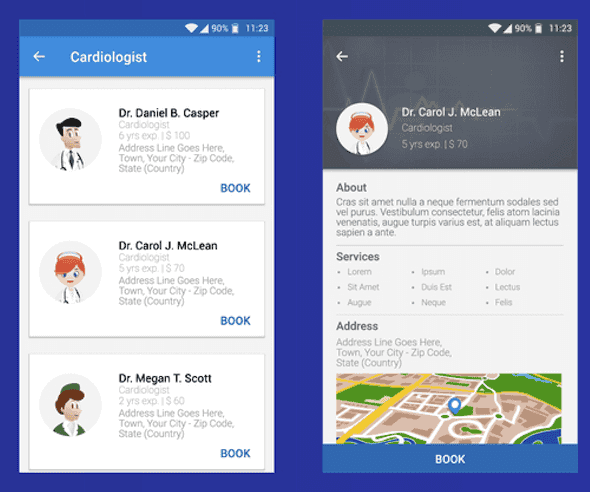A few problems that something like GQL solves
Let’s imagine we’re adding a “list of doctors” page to a hospital UI.
On the screen to the right, we see some evidence that there already exists some API endpoint for a weekly report that has way more detailed information about each doctor than we need for this table, but let’s say it’s missing the “availability” field that determines whether the “Book” button is enabled.
We’d have a few choices about how to proceed
- Use the existing endpoint as-is, except that we add the “availability” field
- We could build a new endpoint that gives us just the “availability” field, and fetch it in parallel with a call to the existing endpoint.
- Build an entirely new endpoint that returns all of the data we need, just for this new page
- Modify the existing endpoint so that it operates in multiple “modes” (maybe depending on a queryParam?)
None of these seem ideal in the long term
If we go with (1) we’re going to end up with an ever-growing list of “doctor” fields. Some of these may also require new DB queries behind the scenes or send large amounts of unnecessary data over the wire, and we’ll pay that added price every time we need a list of doctors for any reason. This is sometimes referred to as over-fetching
If we go with (2) we’re going to end up with a bunch of tiny little supplemental API endpoints. Over time they’ll sort of “pile up” and it’ll be difficult to keep track of which one(s) are used and where. We may notice performance issues on client devices due to number of requests (HTTP/2 multiplexing mitigates this), more QPS hitting the API, and an increased tendency for race condition problems.
If we go with (3) we’re going to end up with an extremely complicated API, that significantly diverges from the RESTful model (which would seem to indicate that GET /doctors should be the single path where we get a list of doctors)
If we go with (4) we’ll introduce some non-trivial complexity to the existing endpoint, and introduce the need for more test cases. What happens when we have several orthogonal modes that all can be used in conjunction with each other?
levelOfDetail |
includeAvailability |
includeSpecialization |
|
|---|---|---|---|
levelOfDetail |
--- | ? | ? |
includeAvailability |
? | --- | ? |
includeSpecialization |
? | ? | --- |
We start to see that we’ll end up with N! scenarios to build, test and maintain
Enter: GraphQL
GraphQL aims to address this problem by getting rid of the idea of a “one size fits all” definition of what REST APIs would call a “resource”. Clients can ask for what they need, and even combine multiple resources into a single query.
We’ll learn all about how it works once we get “hands on” with our course project: a Twitter clone.
